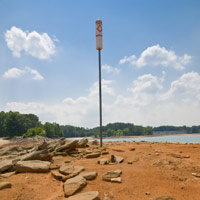Water Supplies
Climate change is affecting where, when, and how much water is available for people to use. Many parts of the world already have very little water, and climate change could make this problem worse. Rising temperatures, changing precipitation patterns, and increasing droughts will affect the amount of water in lakes, rivers, and streams, as well as the amount of water that seeps into the ground to replenish ground water.
What's at stake?
Public Water Supplies
 In 2007, a major drought hit the southeastern United States. Lake Lanier, which is the main source of drinking water for the Atlanta area, was reduced to record–low water levels. People had to use less water in their homes and businesses and make other changes, such as not watering their lawns.
In 2007, a major drought hit the southeastern United States. Lake Lanier, which is the main source of drinking water for the Atlanta area, was reduced to record–low water levels. People had to use less water in their homes and businesses and make other changes, such as not watering their lawns.
- What can people do about it?
As climate change continues, people might have to prepare for water shortages by using less water.
What's at stake?
Lakes, Rivers, and Streams
 Many places rely on snowmelt to fill the lakes, rivers, and streams that help keep drinking water reservoirs full and provide water to irrigate crops. For example, many parts of the western United States depend on water from the Colorado River, which is fed by melting snowpack in the Rocky Mountains. Less snowpack and earlier snowmelt will reduce the amount of water flowing into the Colorado and other rivers.
Many places rely on snowmelt to fill the lakes, rivers, and streams that help keep drinking water reservoirs full and provide water to irrigate crops. For example, many parts of the western United States depend on water from the Colorado River, which is fed by melting snowpack in the Rocky Mountains. Less snowpack and earlier snowmelt will reduce the amount of water flowing into the Colorado and other rivers.
- What can people do about it?
Communities might have to find new sources of water to support their needs. People might also have to adapt by using less water.
Learn more
- Take an expedition to southwestern Africa to explore the connection between climate change and droughts.
- Find out more about how people can prepare for droughts.